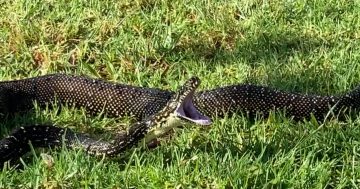
The most common snake in Canberra is the eastern brown snake, which has the second most toxic venom of any land snake in the world.
The snakes in the grass are coming out of hiding in Canberra and for once it has nothing to do with politics – with the deadly eastern brown snake displaying a more obvious kind of venom.
As the weather starts to warm up, snakes are on the hunt for food, water and a mate – with Canberrans being warned that they are becoming more active and visible.
This week alone, the Canberra Snake Rescue and Relocation service has gone to around six callouts a day, catching a five-foot brown snake (the biggest so far this season) from someone’s garden on Monday and doing a tricky rescue of a brown snake from meshing in Pialligo on Wednesday.
“It is very busy,” said the service’s co-owner, Luke Dunn. “It is prime time with breeding season now – we’re getting a lot of calls.”
“The eastern brown snake is the most common one we’re dealing with in Canberra. It has the second most toxic venom of any land snake in the world.”
A spokesperson for the ACT Environment, Planning and Sustainable Development Directorate said that snakes seem to be out and about more this season due to the dry conditions.
“Because of the dry conditions there is a higher likelihood snakes will leave nature parks and reserves looking for food and water and are coming into urban areas,” the spokesperson said.
ACT Conservator Ian Walker is urging Canberrans to be particularly mindful of snakes if they are bushwalking and also to do what they can to discourage snakes from entering their yards.
“Canberra has an abundance of native wildlife, which includes eight species of snakes. The warmer spring weather means snakes will start to emerge from hibernation in search of food and water,” Mr Walker said.
“Eastern brown snakes are most frequently seen across Canberra from October until March. While they are highly venomous, they are naturally shy and will only strike when provoked.

Eastern brown snakes are most frequently seen across Canberra from October until March. File photo.
“If you do come across a snake the best approach is not to catch or kill them, as harassing the reptile may cause it to defend itself by striking.
“It’s also timely to remind people that snakes are a protected species, and under the Nature Conservation Act it is an offence to capture, harm or kill them,” he said.
“Canberrans can discourage snakes from entering their yards by keeping lawns and gardens well-maintained, storing piles of wood or compost heaps above ground and ensuring pet food and water bowls are not accessible to native wildlife.
“When out bushwalking, people should wear enclosed shoes, be alert and avoid walking through long grass. If people encounter a snake they should move away and let it go on its way.”
Below is a short video from the Environment, Planning and Sustainable Development Directorate providing tips on dealing with snakes in the bush capital.
In the ACT, the eastern brown snake can vary in colour from brown to grey and can even be blackish, dark brown or orange. Young snakes may be entirely brown or may have a black patch on their head and a black band on their neck.
Other snakes that tend to be seen only occasionally in the ACT include the red-bellied black snake, the tiger snake and the black-headed snake.
Mr Dunn said that he and his partner Emma Carlson started their business in 2015 and were the first snake catching business to be licenced in the ACT.
He mainly deals with eastern brown snakes but said he caught his first tiger snake recently. Mr Dunn said that after he catches snakes he relocates them out in the bush, away from suburban areas.
According to Mr Dunn, the ‘snake season’ started off slowly this year because of the cooler weather but became really busy when the school holidays began.
Mr Walker provides the following advice for Canberrans who see a snake:
- when left alone, snakes present little danger to people and animals
- if you see a snake, move pets and children away until the snake moves off
- when bushwalking let friends or family know where you’re going, wear enclosed shoes, take a backpack with a first aid kit and be alert at all times
- keep gardens, sheds and aviaries well-maintained
- don’t attempt to capture or kill snakes, instead call Access Canberra on 13 22 81 for further advice, or call a licensed snake catcher.
Click here for more information about snakes in the ACT, including snake removal.















